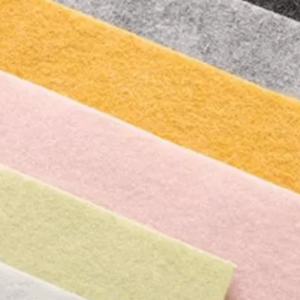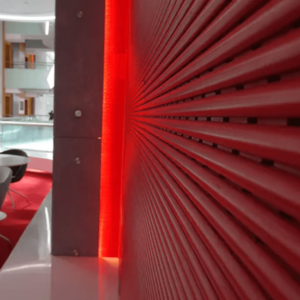Acoustic Corner Bass Trap Foam Panels
Effectively reduce low-frequency reverberations with high-performance, lightweight, and fiber-free Bass Trap Foam Panels from Gitco-sa.com. Triangular design for uniform acoustic control in various spaces.
Description
Acoustic Corner Bass Trap Foam Panels available at Gitco-sa.com are specifically engineered from polyurethane to effectively reduce reverberations uniformly across the desired acoustic spectrum, particularly targeting problematic low-frequency sounds. Their triangular pattern is designed for corner placement, where bass frequencies tend to accumulate, making them a high-performance solution for improving the acoustic clarity of any room. Constructed from open-cell polyurethane acoustic foam, these panels are fiber-free and lightweight, ensuring easy handling and installation for optimal bass control.
By increasing air resistance, the acoustic foam attenuates airborne sound waves, reducing their amplitude and dissipating the energy as heat. These Bass Trap Foam Panels are crucial for achieving balanced acoustics and preventing muddy or boomy sound, enhancing speech intelligibility and overall sound quality in various environments, including:
Applications of Corner Bass Trap Foam Panels :
- Offices
- Schools
- Meeting Rooms
- Hotels
- Auditoriums
- Recording Studios
- Conference halls
- Broadcasting Studios
Product Details of Corner Bass Trap Foam Panels :
- Core: Open Cell Polyurethane Acoustical Foam
- Thickness (mm): Custom thickness available
- Sizes (mm): 300mm x 300mm x 600mm, 350mm x 300mm x 600mm, custom sizes also available
- Acoustic Properties: NRC 0.75 (varies with thicknesses and mounting)
- Density: 1 lbs/cub.ft and 2 lbs/cub.ft
- Colour: Charcoal Grey
- Flammability: Meets UL94 HF -1 Standard
- Mounting type: Type A
- Installation: Recommended with ASI S.T.O.P Noise Acoustical Adhesive or any suitable construction adhesive, typically placed in room corners.
Understanding Polyurethane Acoustic Bass Trap Foam Panels:
- What are polyurethane acoustic bass trap foam panels?
- They are specialized acoustic foam panels made from polyurethane foam, designed with shapes (often triangular or corner-filling) and thicknesses optimized to absorb low-frequency sound waves (bass) that tend to accumulate in room corners.
- How do polyurethane acoustic bass trap foam panels work?
- Their porous, open-cell structure allows bass frequencies to penetrate the foam. The thickness and shape help to trap and dissipate these longer wavelengths, reducing bass build-up, standing waves, and muddy sound.
- What are the primary benefits of using polyurethane acoustic bass trap foam panels?
- Improved bass response clarity and tightness, reduction of low-frequency standing waves and room modes, a more balanced and accurate overall sound, relatively lightweight and easy to install, and a cost-effective solution for bass control.
- Where are polyurethane acoustic bass trap foam panels commonly used?
- Recording studios, home theaters, music practice rooms, mixing and mastering suites, broadcast studios, and any room where accurate bass reproduction is critical.
- What are polyurethane foam bass traps made from?
- They are made from polyurethane foam, often with specific densities and formulations optimized for low-frequency absorption.
- What are the common shapes and sizes of polyurethane acoustic bass trap foam panels?
- Common shapes include triangular prisms designed to fit into room corners (corner bass traps) and sometimes thicker, rectangular blocks. Standard lengths are often 2 or 4 feet, with triangular faces ranging from 12 to 24 inches per side and thicknesses from several inches to a foot.
- Why are bass traps often placed in corners?
- Low-frequency sound waves tend to reinforce themselves in room corners, leading to areas of high pressure (bass build-up). Placing bass traps in corners maximizes their effectiveness in absorbing these problematic frequencies.
- How do polyurethane bass traps compare to bass traps made from other materials?
- Polyurethane foam bass traps are a common and affordable option. Other materials like rigid fiberglass or mineral wool can also be used in bass trap designs and may offer superior low-frequency absorption per unit volume, but foam is often easier to work with for DIY and smaller setups.
Selecting and Specifying Polyurethane Acoustic Bass Trap Foam Panels:
- How do I choose the right size and number of polyurethane bass traps for my room?
- This depends on the room’s dimensions, the severity of the bass issues, and the desired level of low-frequency control. Larger rooms generally benefit from more and larger bass traps. Treating all four vertical corners is a common starting point.
- What thickness of polyurethane foam bass trap should I choose?
- Thicker bass traps are generally more effective at absorbing lower frequencies. Look for traps that are at least 4 inches thick, and ideally thicker (6-12 inches or more) for better low-end control.
- How do I determine the placement of polyurethane bass traps in my room?
- The corners of the room (where walls meet and where walls meet the ceiling/floor) are the most critical areas. Treating all four vertical corners is a good starting point. Additional traps can be placed at mid-wall points if needed.
- Can polyurethane bass traps be used in conjunction with other acoustic treatments?
- Absolutely! Bass traps are often the foundation of good room acoustics and are typically used in combination with broadband absorbers (like flat or shaped foam panels) to address mid and high-frequency reflections.
- Are there different densities of polyurethane foam used in bass traps, and how does this affect performance?
- Yes, denser foam generally offers better low-frequency absorption. Look for bass traps made from high-density polyurethane foam specifically designed for acoustic treatment.
- Can I build DIY bass traps using polyurethane foam?
- Yes, polyurethane foam can be used for DIY bass traps. Ensure you choose foam with sufficient thickness and density for effective low-frequency absorption.
Installation and Maintenance of Polyurethane Acoustic Bass Trap Foam Panels:
- How do I install polyurethane bass trap foam panels in corners?
- Corner bass traps are typically designed to fit snugly into the corners. They can be attached using spray adhesive, construction adhesive, or strong double-sided tape.
- Can polyurethane bass traps be easily repositioned after installation?
- Depending on the adhesive used, repositioning can be difficult and might damage the foam or the wall surface. Plan your placement carefully before adhering to them.
- How do I clean polyurethane bass trap foam panels?
- Gentle vacuuming with a soft brush attachment is the best way to remove dust. Avoid using liquids or harsh chemicals.
- Do polyurethane bass trap foam panels degrade or lose their effectiveness over time?
- High-quality acoustic foam can last for many years. However, exposure to UV light can cause discoloration, and physical damage can reduce their effectiveness.
Purchasing and Cost of Polyurethane Acoustic Bass Trap Foam Panels:
- Where can I buy polyurethane acoustic bass trap foam panels?
- They are available in Gitco specializing in acoustic treatment.
- How much do polyurethane acoustic bass trap foam panels cost?
- The cost varies depending on the size, thickness, density, shape, and brand. Corner bass traps are often sold individually or in pairs. Prices can range from relatively affordable to more expensive for larger, high-density options.
Achieve balanced and clear acoustics by controlling low-frequency build-up with the high-performance Bass Trap Foam Panels from Gitco-sa.com. Explore our standard and custom-size options to find the perfect solution for your specific acoustic needs in offices, studios, schools, and more.
Additional information
| Applied on | Ceiling, Wall |
|---|---|
| Material Type | Polyurethane (PU) |
| Core | Open Cell Polyurethane Acoustical Foam |
|---|---|
| Thickness (mm) | Custom thickness |
| Sizes (mm) | 300mm x 300mm x 600mm, 350mm x 300mm x 600mm & also custom sizes |
| Acoustic Properties | NRC 0.75 ( varies with thicknesses and mounting ) |
| Density | 1lbs/cub.ft and 2 lbs/cub.ft |
| Colour | Charcoal Grey |
| Flamability | Meets UL94 HF -1 Standard |
| Mounting type | Type A |
| Installation | ASI S.T.O.P Noise Acoustical Adhesive or any construction adhesive |
Sound Absorption Coefficients
| Thickness | 125Hz | 250Hz | 500Hz | 1KHz | 2KHz | 4KHz | NRC |
|---|---|---|---|---|---|---|---|
| BS-1 | 0.46 | 1.00 | 0.78 | 0.64 | 0.63 | 0.70 | 0.75 |
| BS-2 | 0.90 | 0.84 | 0.80 | 0.64 | 0.62 | 0.70 | 0.75 |










Reviews
There are no reviews yet.